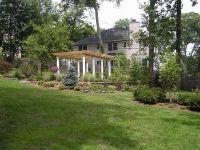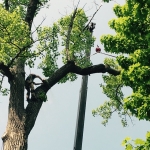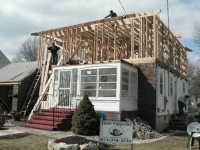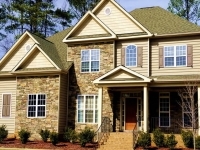Squier Farmhouse Redevelopment
As I recall, it used to be a requirement in Maplewood, and I believe also in South Orange, that the town arborist would have to approve removal of healthy trees that were over a certain diameter. We filed the paperwork once for an old tree in our yard that needed removing. The next time we had a similar tree, the approval wasn't required any more.
I think those required reviews are a good idea in towns like ours.
mrincredible said:
To me it seems like like a very irresponsible (and self-defeating) move by the developer.
From the developer's viewpoint, it all depends on the money.
nohero said:
From the developer's viewpoint, it all depends on the money.
I guess it depends on how soon the town lets him start construction again. Every day that he owns that property and can't move toward selling the new houses cuts into his bottom line. I'm sure it makes the construction easier to not have to work around the existing trees, so that probably helps the developer's timeline. And waiting for permits and approval might have slowed things down.
So was it a calculated risk by the developer? He had to know he could get slapped. Maybe the risk was worth it in his mind.
The Village Green article stated that the developer did not obtain the required permits that would have been required prior to removing the trees. Implication was that the permits would not have approved. The Village and possibly the State are looking into legal action. I am not sure how one makes up for removing mature trees, whose removal would likely exacerbate future flooding in the area. Ida showed us that flashing flooding is now a real problem that can and did result in loss of life.
joan_crystal said:
Implication was that the permits would not have approved.
That seems like the most likely reason for the developer to do what he did. He just went ahead and did it figuring once it was a done deal he'd be able to move on.
I absolutely agree with you about the increased flooding risk with those trees gone. Mature trees soak up a lot of water from the ground every day, so removing one (or more) increases the chance you'll have saturated ground when a big rainstorm rolls in. Plus their root system stabilizes the soil.
I have a lovely mature tree in my front yard and every time there is a storm, I keep thinking I should have the tree removed and then plant some new trees.
I hear ya. My wife will be forever leery of any tree that gets taller than oh, about 6 feet. There are three 80ft+oak trees in ours and the neighboring backyards. There they have better anchoring than those right out at the street but every time the wind blows hard like last night she freaks out. Followed a little less intensely by my own anxiety.
But I know how they have helped out this area's ability to handle heavy rain.
PeterWick said:
I hear ya. My wife will be forever leery of any tree that gets taller than oh, about 6 feet. There are three 80ft+oak trees in ours and the neighboring backyards. There they have better anchoring than those right out at the street but every time the wind blows hard like last night she freaks out. Followed a little less intensely by my own anxiety.
But I know how they have helped out this area's ability to handle heavy rain.
Removing sentiment from the equation, suburban trees should be managed commercially. When a tree reaches 30-40 years, harvest it for hardwood and plant more trees.
Commercial saw mills will not take wood from suburban yards. There is often embedded metal in the wood (such as clothesline wheels), which would destroy their expensive band saws.
We know this first hand from removal of a giant oak some 25 years ago, which:
- Had a 4'x6' oval cross section.
- Had a split Y-shaped trunk (held together with steel cable).
- Had a tilt towards the house (lifting the soil about 3 feet on the far side)
- Had branches resting on the roofs of not only our house, but also both neighbors.
Yeah I have to imagine the cost of safe tree removal in a residential neighborhood would eat up profit from the wood. I wasn't thinking about the damaging stuff they could encounter.
A neighbor did have a portable sawmill come in and mill a bunch of lumber from a tree he had taken down. No idea what that set him back.
Anyway the issue at hand here is not the general merits of suburban trees. The developer skipped the required permitting process. That's either a major oversight or complete disregard for regulations. Neither option is very good considering part of this project is removal of the new sections attached to an historic house, then restoring the historic section. They're going to need to proceed more carefully to hold up their end of the agreement with the town.
PeterWick said:
I hear ya. My wife will be forever leery of any tree that gets taller than oh, about 6 feet. There are three 80ft+oak trees in ours and the neighboring backyards. There they have better anchoring than those right out at the street but every time the wind blows hard like last night she freaks out. Followed a little less intensely by my own anxiety.
But I know how they have helped out this area's ability to handle heavy rain.
she’s still traumatized. I would be too if a tree falls on my house. We take trees for granted, but a small branch can kill someone.
I don’t think you can even get a permit to cut down trees over a certain measurement in girth, unless it’s dead or badly diseased. This guy made a terrible decision, he will have to pay a hefty fine.
What a shame. I know there is a multilayered procedure for development, better than most places, but damn! What impression of our town led to such entitled behavior?
This project was widely discussed. Has anyone seen the site plan? I'd !like to know if this was underhanded or just plain unplanned for.
DanDietrich said:
This project was widely discussed. Has anyone seen the site plan? I'd !like to know if this was underhanded or just plain unplanned for.
if the town engineer halted construction, my guess it was unplanned for. If they cut the trees down thinking they would get away with it, then they are not from this area. They will learn the hard way that you just can’t do whatever you feel like doing on some land you own.
Jaytee said:
if the town engineer halted construction, my guess it was unplanned for. If they cut the trees down thinking they would get away with it, then they are not from this area. They will learn the hard way that you just can’t do whatever you feel like doing on some land you own.
yeah, but this doesn't really answer the question. The town approved the subdivision in order to save the house. Could the new homes be built with the trees remaining in place? Was the issue addressed during the planning? It should be a check box every time. It may be, I'm just not sure.
There's a lot of case law regarding compensatory damages from unlawful removal of trees. The value is typically based on the commercial value of the lumber, plus a decrease in value by removal of the canopy. Some states also have a multiplier on the damages, NY's is 3x commercial value of the tree.
To Tomcat's point about suburban trees typically not being accepted by sawmills, it would be interesting to see if that could be factored into the commercial value of the lumber or not.
Komarovsky said:
There's a lot of case law regarding compensatory damages from unlawful removal of trees. The value is typically based on the commercial value of the lumber, plus a decrease in value by removal of the canopy. Some states also have a multiplier on the damages, NY's is 3x commercial value of the tree.
To Tomcat's point about suburban trees typically not being accepted by sawmills, it would be interesting to see if that could be factored into the commercial value of the lumber or not.
It seems the added erosion and decrease in water retention ought to be part of the value calculation too. If it's not, this seems like an area of law that climate change should be pushing us to update.
It is my understanding that if a tree removal firm does the work without town permits it is equally culpable with the developer.
(slight drift)
Not in NJ, but here in Wis some of the arborist firms are milling or partially milling the wood from trees they remove. They make part of it up into simple but beautiful tables, etc., and you can also buy the milled lumber from them. Maple, oak, and right now esp. ash, since there's a pest attacking the many curbside ash trees. "Urban wood." https://www.hoppetreeservice.com/urbanwoodlab
I don't imagine it's a big profit center for them, but maybe better than just chipping the wood and selling it for mulch?
Jaytee said:
I don’t think you can even get a permit to cut down trees over a certain measurement in girth, unless it’s dead or badly diseased. This guy made a terrible decision, he will have to pay a hefty fine.
In cases I have known of, the builder or developer is willing to avoid the permit process, takes the tree/s down and just builds the cost of the fine/s into the project. The wild card here is shutting down the construction- that’s huge. Never heard of that happening before, and I served on a NJ historic preservation commission for 19 years!
My guess is that the developer did the math and decided that any penalty for cutting down the trees would still allow for profitable development of the property. They are using the "ask for forgiveness rather than permission" strategy.
Our town governments profess to care about trees but they let developers do whatever they please. There are several lots that have been clear cut with the necessary approvals.
One of the trees was a healthy 42" diameter white oak, planted some time before 1811.
tom said:
One of the trees was a healthy 42" diameter white oak, planted some time before 1811.
That tree was approved for removal. Apparently, the planning board approved the removal of 23 trees and the developer removed 38. He paid the maximum fine that the Village could levy and the stop work order has been removed for two of the three lots. The other lot, which had trees removed that were in the riparian zone, has been referred to the NJDEP for disposition. The Village's statement can be found here:
KarenMarlowe said:
That tree was approved for removal. Apparently, the planning board approved the removal of 23 trees and the developer removed 38. He paid the maximum fine that the Village could levy and the stop work order has been removed for two of the three lots. The other lot, which had trees removed that were in the riparian zone, has been referred to the NJDEP for disposition. The Village's statement can be found here:
Thanks Karen. I was just wondering this morning what was going on.
Looks like the fine was $2,000 total. But I think the NJDEP can impose more. It doesn't seem like a substantial fine, but it does eventually come off the developer's bottom line. I don't know what he was expecting as a return on his investment for this project.
$2000 is shamefully low and certainly won't deter any developer from doing it in the future. Can SO enact a fine schedule that would actually deter people from removing trees illegally?
Komarovsky said:
$2000 is shamefully low and certainly won't deter any developer from doing it in the future. Can SO enact a fine schedule that would actually deter people from removing trees illegally?
The fines are set by the state, but mr incredible is right in that the DEP fines can be significantly more. Whether they will be is anyone’s guess.
KarenMarlowe said:
The fines are set by the state, but mr incredible is right in that the DEP fines can be significantly more. Whether they will be is anyone’s guess.
I vaguely remember a guy in Chatham who had to pay thousands of dollars because he removed more trees than he was allowed to remove on the permit. I was doing work out there for my friend who had just moved from maplewood to Chatham. Another person I know on elmwood avenue had to pay $2500 for removing four trees from his property without a permit.
So I have no idea how much in fines this person will have to pay. I’m thinking a 42 inch diameter will get him a hefty fine from the state.
Jaytee said:
KarenMarlowe said:
The fines are set by the state, but mr incredible is right in that the DEP fines can be significantly more. Whether they will be is anyone’s guess.
I vaguely remember a guy in Chatham who had to pay thousands of dollars because he removed more trees than he was allowed to remove on the permit. I was doing work out there for my friend who had just moved from maplewood to Chatham. Another person I know on elmwood avenue had to pay $2500 for removing four trees from his property without a permit.
So I have no idea how much in fines this person will have to pay. I’m thinking a 42 inch diameter will get him a hefty fine from the state.
That big tree was approved for removal by the Village. This exhibit shows the trees that were approved for removal (and apparently marked by the Village), the trees that needed to be (re)planted and the trees that were to remain. The trees on the right side of this exhibit are the ones that are in question, being in the riparian zone.

Sponsored Business
Promote your business here - Businesses get highlighted throughout the site and you can add a deal.
























I guess I'm kinda late to discussing this. There's another snag in redeveloping the property at 167 North Ridgewood in Soutj Orange. It's the sprawling house overlooking Floods Hill. The original section dates to c 1774 but it's been expanded a few times. A developer wanted to raze it and construct three new houses. A compromise was reached allowing construction of two new houses and restoration of the historic section of the Farmhouse.
Apparently the developer overstepped their bounds by removing all of the trees from the property over the last week or so. So the town has halted any further construction work.
It's a pretty big deal for a few reasons. There were some large mature trees on the property which can't be replaced in our lifetimes. The trees would also help with runoff into the East Branch of the Rahway River. There's a small gully on the property that becomes a stream when it rains, and that will be affected as well.
To me it seems like like a very irresponsible (and self-defeating) move by the developer.
https://villagegreennj.com/towns/south-orange/construction-halted-as-south-orange-responds-to-clear-cutting-of-trees-at-historic-squier-property/